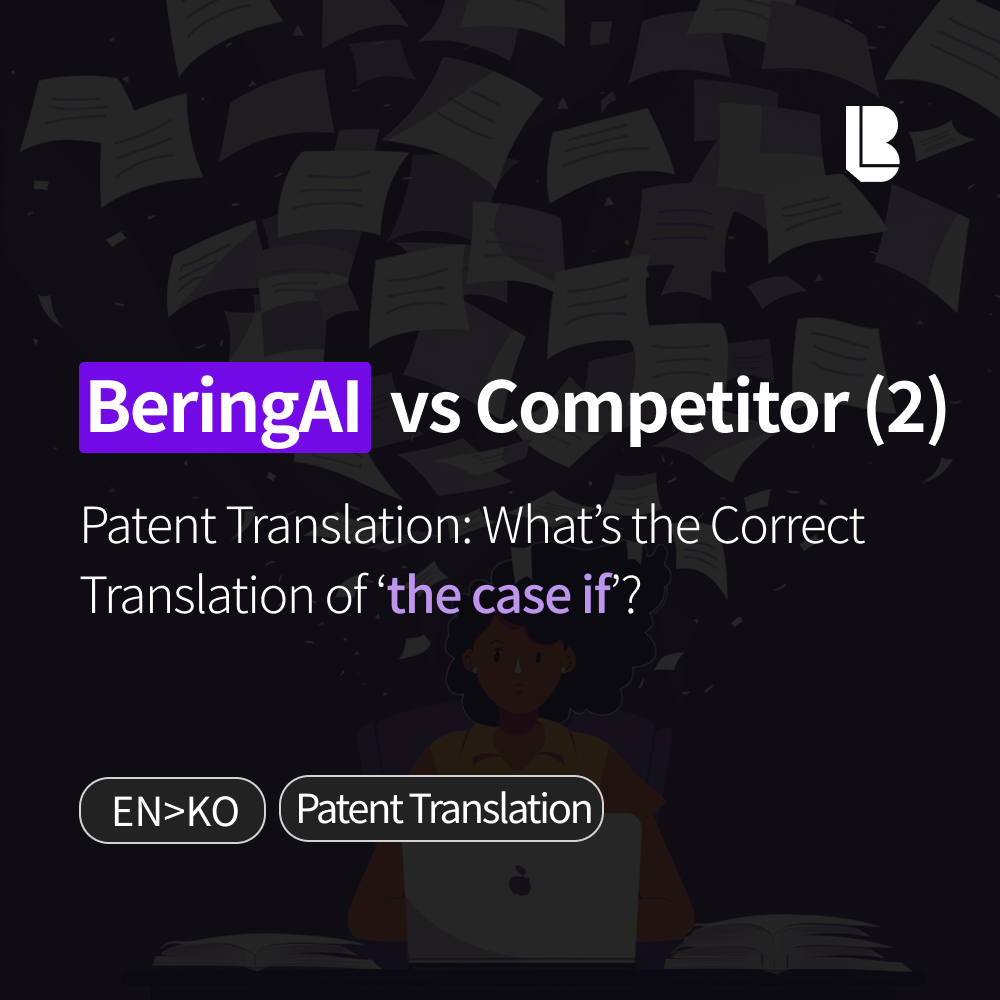Today, we’re back with the second part of our patent translation comparison series, featuring a detailed look into how BeringAI delivers precise translations while competitors often fall short. Let’s dive deeper into why accurate patent translation is so crucial.
Why is patent specification translation so important? A patent is a legal document that protects the rights of the inventor. According to U.S. patent law, to obtain a valid patent, a complete and precise specification of the invention must be submitted. This specification serves as the basis for the exclusive rights granted to the inventor. Hence, accurate translation is critical.
When translating a patent, it’s essential to stay faithful to the original content. After the filing date, no new information can be added, so it is crucial to write the specification, claims, and drawings carefully during the initial filing. A mistranslation can significantly alter the scope of patent protection.
This is why high-quality translations are a must when translating patent specifications. It’s not just about transferring words from one language to another—it’s about accurately conveying legal meaning and technical details. Now, let’s compare the translations of BeringAI and a competitor (Company D) and analyze which one is more accurate.
✍️ BeringAI Translation vs. Competitor D’s Translation
[Original] Thus, the protein in the concentrated product is less subject to stress conditions (e.g. shear forces) as it would be the case if the stabiliser is added after the concentrating step.
[BeringAI] 따라서, 농축된 생성물 중의 단백질은, 안정화제가 농축 단계 후에 첨가되는 경우와 같이, 응력 조건 (예를 들어, 전단력)에 덜 영향을 받는다.
[DeepL] 따라서 농축된 제품의 단백질은 농축 단계 후에 안 정제를 첨가할 때와 같이 응력 조건(예: 전단력)의 영향을 덜 받습니다.
1️⃣ Tone and Abbreviation: Direct Translation is Key
Patent specification translation requires more than just converting language—it demands legal and technical precision. What should the tone and style of patent translations look like?
In contrast to English, Korean includes different levels of formality. However, in patent specifications, it’s crucial to avoid using honorifics and instead opt for a more direct style, as seen in BeringAI’s translation. For example, “덜 영향을 받는다” (“less affected”) is more appropriate than the more casual “덜 받습니다” used by Company D. Precision in the purpose of the invention is key here.

Another common error in patent translation involves handling abbreviations. Even when the original uses “e.g. shear forces,” BeringAI correctly expands this to “예를 들어 (for example)” to enhance clarity. It is crucial to fully spell out abbreviations the first time they appear, which improves the document’s clarity and reduces the chance of misunderstanding.

2️⃣ “the case if”: Direct Translation vs. Interpretation?

Looking at the examples, “the case if” is translated differently by each. Which one is correct? A direct translation would render it as “~의 경우와 같이,” which is how BeringAI handles it. Competitors like Company D, however, tend to use more interpretative translations such as “때와 같이” (“as when”).
In patent specifications, a direct translation like BeringAI’s is more suitable. Why? Because patent specifications are legal documents, and minimizing ambiguity is critical. Interpretative translations can distort the original intent and increase the chance of errors when translating into additional languages.
BeringAI accurately captures the essence of patent language, keeping the original nuance intact. This helps maintain the correct legal protection scope of the patent.
3️⃣ “product”: Understanding Technical Terminology is Essential

Patent translation involves many technical terms, and special care must be taken with their usage.
In this example, we see the term “product.” In the context of a chemical patent, “product” typically refers to a “생성물” (resultant substance), a material produced from a chemical reaction. However, many generic translators often translate “product” as “제품” (product), which can dramatically change the meaning. Misunderstanding technical terms like this can lead to a patent’s scope becoming unclear or ambiguous.
Consider translating the sentence “The reaction produces a new product.” If it is rendered as “반응이 새로운 제품을 생산한다,” it could lead to significant misunderstandings. The correct translation should be “반응이 새로운 생성물을 만든다.”
Have you seen how machine translations can lead to dangerous errors in specialized fields like patent translation? This is why BeringAI was created. BeringAI specializes in legal and patent AI translation, accurately translating terms like “product” within the proper technical context.
But we didn’t stop there. To combine the efficiency of AI translation with the accuracy of human expertise, we also offer our BeringAI+ service. In highly specialized fields like patent translation, BeringAI+ shines by offering an unmatched level of efficiency and precision.
If you’re in charge of protecting your company’s valuable patents or ensuring the correct translation of technical terms, choose BeringAI without hesitation. With accuracy that outperforms generic machine translators and efficiency that competitors can’t match, we’ll help you protect your intellectual property. Experience a new dimension of patent translation with BeringAI!
Our services are already trusted by over 130 law firms and global enterprises worldwide. Protect your intellectual property with top-tier patent translations by using BeringAI or BeringAI+—offering translations that are 3x faster and 40% more cost-effective.
🚀 Start your legal translation quickly and easily with BeringAI.
🔍 Use BeringAI+ for reliable translations reviewed by experts!


